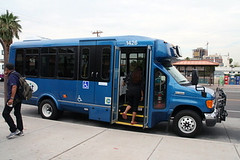Towards a transit system for Greenbelt
People in Greenbelt want a better transit system, according to this article from the Gazette, "Greenbelt residents push for more bus runs." Here's a potential answer. They should develop an "intra-neighborhood" transit system similar to what is provided in Tempe, Arizona.
Extract from a past blog entry:

Venus Lee/The Arizona Republic. Hundreds of people have signed petitions, sent e-mails and made phone calls voicing opinions about if and where free shuttle service should be expanded throughout the northern half of Tempe.
In my People's Transportation Plan (in part based on a paper I wrote in May 2007) I suggested the creation of an intra-neighborhood transit network* that could be free, and oriented to getting people to and from within a neighborhood, to transit lines and stations without having to drive, and including delivery of goods and services from local commercial districts. And I suggested this could be a free service
It turns out that Tempe Arizona has refigured part of its bus service to do exactly that.
See the Tempe In Motion (the city's Department of Transportation) website for information on the Orbit bus system as well as these articlea from the Arizona Gazette, "Neighborhood circulator buses bring sense of community" and "Venus, Mercury bus routes are in Tempe's Orbit circulation." (Note that the commenters for the later article weren't supportive.)
From the Orbit webpage:
Orbit (a FREE service) uses mini-buses to serve residential areas and connect them to local destinations such as shopping areas, other neighborhoods, major bus routes, schools and multi-generational centers. All Orbit routes run from 6 a.m. to 10 p.m. every 15 minutes, 7 days a week. "No stop zones" occur in between the crosswalks of all schools served by an Orbit route. The Orbit routes use “flag” stops, which means that the driver will pick up and drop off passengers in residential neighborhoods provided it is safe to do so.
Note that the Tempe In Motion website is another example of a best practice government agency transportation website, focused on mobility, not just transit.
-------
Greenbelt could do the same thing, with service provided during the hours that the subway system is open, and using the subway station as a primary hub for the service configuration.
Labels: neighborhood-based transportation planning, transit, transportation planning



0 Comments:
Post a Comment
<< Home